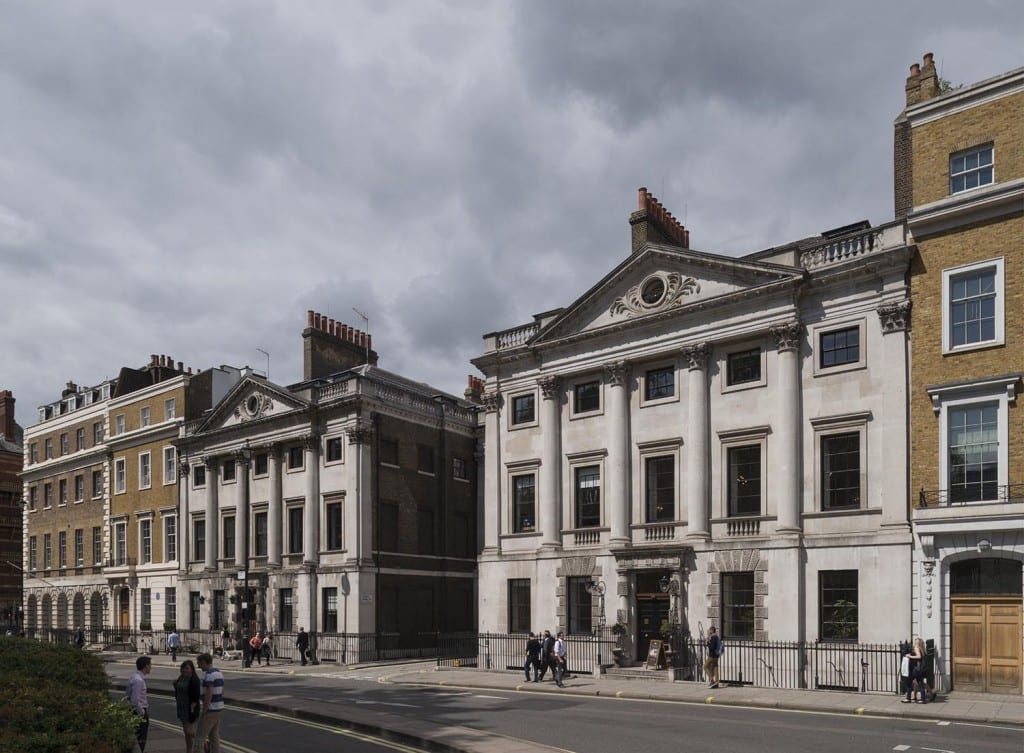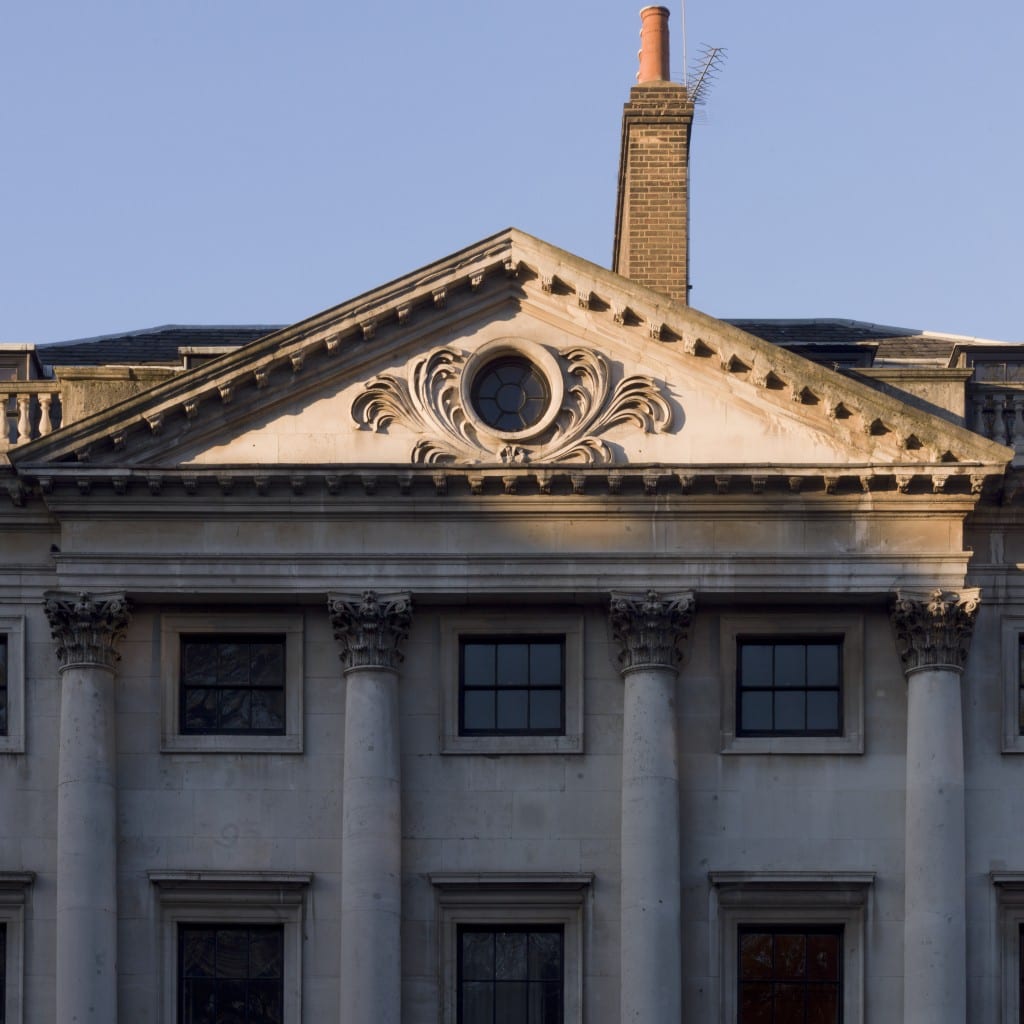30 Portland Place: London’s Guggenheim Museum that never was
By the Survey of London, on 26 February 2016
In the summer of 1939 plans were almost complete for the wealthy American heiress and socialite Peggy Guggenheim to open an Institute of Modern Art in London, in a house at 30 Portland Place specially rented for the purpose from Sir Kenneth Clark, who had been living there for some years with his family and his own remarkable collection of paintings and furnishings. The art historian and critic Herbert Read was already lined up as museum director on a five-year contract and Ms Guggenheim had left for Paris to acquire more artworks, with a list of desiderata drawn up by Read. But then war broke out…

30 Portland Place, view from the north-west (© Historic England, Chris Redgrave). If you are having trouble viewing images, please click here.
No. 30 was one of a block of fashionable terraced houses, built in the 1770s–90s as part of the Adam brothers’ development at Portland Place. With the neighbouring properties to its south at Nos 26 and 28 it forms an elegant trio of period houses, all with good Adam interiors. In plan the house was straightforward, though typical of the care Robert Adam took in varying room shapes, with partitioning used to introduce curves at the far end of the rear ground-floor breakfast parlour and at both ends of the second drawing room, echoed by other shallow curves in the rear closet wing – features that are still traceable in the house today. Several Adam office designs for chimneypieces, friezes and ceilings for No. 30 survive in the collection at Sir John Soane’s Museum, but only the drawing-room ceilings remain in situ. [1] Much of the eighteenth-century décor was lost during a comprehensive refit in 1901 for the Liberal politician and merchant banker William Charles Heaton-Armstrong, who lived there with his family from 1898 until around 1911, when the failure of his bank forced him to move. His successor in 1911, Lady Margaret Jenkins, spent heavily reversing much of this, reintroducing ‘correct’ Georgian panelling and mantelpieces and stone hall flooring which she thought more in keeping with the date of the house. [2]
In 1934 No. 30 was taken by Sir Kenneth Clark, then newly appointed as Director of the National Galley and Surveyor of the King’s Pictures, and his wife Jane. Clark remembered the house as being ‘far too big’, and the piano nobile of Adam rooms as ‘completely unnecessary’, but he and his wife made use of the space to display artworks and to entertain on a grand scale. Photographs now in the RIBA show the house during their residence, with curtains, rugs and other fittings that the Clarks commissioned from contemporary artists and friends like Marion Dorn, Duncan Grant and Vanessa Bell; the painter Graham Bell lived for a while in an upstairs room. [3]

Kenneth Clark by Howard Coster, 1934 (© National Portrait Gallery, London).

The dining room at 30 Portland Place in 1938, during Kenneth Clark’s residence, with curtains designed by Duncan Grant, and George Seurat’s Le Bec du Hoc, Grandcamp (now in the National Gallery) above the chimneypiece. (Photograph by Alfred Cracknell, © RIBA)

The sitting room at 30 Portland Place in 1938, with a rug designed by Marion Dorn, and what appears to be one of Paul Cézanne’s studies of Château Noir above the chimneypiece. (Photograph by Alfred Cracknell, © RIBA)
But by the summer of 1939, with war looming, the Clarks were keen to move their children out of London, and Sir Kenneth informed the Howard de Walden Estate that a ‘Mrs Goggenheim’ [sic] had expressed an interest in taking his house on a five-year lease to establish an Institute of Modern Art. By this date Peggy Guggenheim had closed her short-lived commercial gallery in Cork Street, Guggenheim Jeune, and was turning her attention to establishing a museum of modern art in Europe, preferably in London. [4]
The choice of Herbert Read as museum director was a canny one. As editor of the leading art magazine Burlington Review, he was at the time probably Britain’s best-known advocate of modern art. But it took the offer of a five-year contract from Ms Guggenheim to persuade him to relinquish his editorship. With such a large house intended for what, initially, would be a small museum, the plan was for Read and his family to reside on one upper floor, Guggenheim on another, though apparently they quarrelled about who should have which floor. There seems to have been genuine affection in their relationship: she regarded Read as a bit of a father figure, later reminiscing: ‘he treated me the way Disraeli treated Queen Victoria’. For his part, Read often signed letters to Ms Guggenheim as ‘Papa’. [5]

Herbert Read by Howard Coster, 1934 (© National Portrait Gallery, London).
With everything decided, towards the end of July 1939 Peggy Guggenheim began to make plans for a trip to Paris to buy suitable works for the new museum. Read gave her a list of possible loans and acquisitions, and had already told the press that the opening show would trace the development of modern art since 1910, beginning with Matisse. The collector and gallery owner Roland Penrose, later a co-founder of the ICA, offered to lend some of his Picassos for the first show. The exact content of Read’s list is not known, but Matisse was one of the names that Peggy Guggenheim crossed off as being not ‘modern’ enough for her tastes; others to suffer the same fate included Cézanne and Rousseau.
But the outbreak of war early in September put paid to the project, even though the lease to the Portland Place house had been agreed (but not signed). Sir Kenneth Clark later suggested letting it rent-free as a centre for artists to meet and exhibit their work, but it was requisitioned in 1940 and damaged by bombing in 1941, since when it has seen a variety of commercial uses. Herbert Read was dismissed, never having held office. Once the dust had settled, Read rather ungenerously wrote to the artist Ben Nicholson about the Guggenheim affair: ‘Never in business matters rely on a single patron particularly if that patron is a woman and an American’ – this despite the fact that he had already been paid and allowed to keep an advance of £2,500, half his five-year salary.
The aborted Portland Place museum did, however, have one lasting legacy. Peggy Guggenheim held on to Read’s ‘shopping list’, which she later revised with the aid of artist friends such as Marcel Duchamp and Theo van Doesburg’s widow, Nellie; and the works that she then acquired – including masterpieces by Georges Braque, Salvador Dalí, Piet Mondrian and Man Ray, were to form the basis for her now world-famous private collection of abstract and Surrealist art.
References
[1] Sir John Soane’s Museum, Adam drawings, vol. 13/122–3; vol. 24/139–44; vol. 53/64
[2] Much of this and the succeeding paragraphs is based on correspondence files belonging to the Howard de Walden Estate Archive
[3] Kenneth Clark, Another Part of the Wood. A Self Portrait, 1985 edn, pp. 238–9, 251, 276
[4] Howard de Walden Estate Archive, property files for 30 Portland Place
[5] This and the succeeding paragraphs are largely based on Mary V. Dearborn, Mistress of Modernism: The Life of Peggy Guggenheim, pp. 158–63: Peggy Guggenheim: A Celebration, exhibition catalogue, 1998/1999, pp. 47–9: http://www.guggenheim-venice.it/inglese/museum/peggy.html
 Close
Close





























